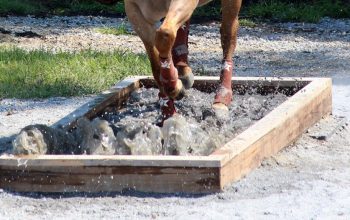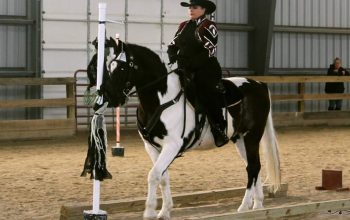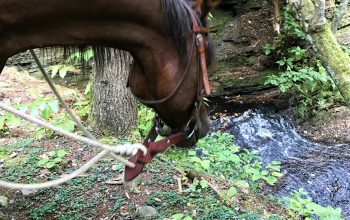By Bev Roberts
North American Trail Ride Conference

Really? You bet! While out on the trail, you’ll encounter many things. Your strategies for handling them are as varied as the circumstances that arise. Here are a few strategies to keep in mind until you develop your own.
Anxious/excited Horses (including yours)
If your horse is anxious, impatient, buddying, nervous or jigging, finding a pocket is a useful strategy. Do it by pulling off the trail and letting those behind to pass you and get out of sight. Now you are in a new pocket. You have the opportunity to work at settling your horse, getting her/him to listen to you, and to just walk. You both can relax. Should someone come up behind you, let her or him pass and settle your horse again.
Do whatever you do at home to settle your horse – circling, one rein stop, picking up one rein and turning her/his head, backing up, whatever. Do it consistently every time s/he acts up on the trail, even in front of a judge (you may get a plus in horsemanship) until “Old Dobbin” gets the idea. If it is any comfort to you, remember:
• Everyone out there has dealt with the same problems as you when they first started competitive trail riding (CTR) or when they introduced a new, young horses to the sport. They understand. Most will help and encourage you.
• It usually takes competing in two to three rides for your horse to figure out the whole “CTR thing.”
• After wasting so much energy on the first day of a ride, most horses are calmer and more willing to be team players on the second day. (Did I hear a sigh of relief?)
If you are in a group and the other riders agree, another strategy is to put your anxious, jigging horse, between two quiet, calm horses – a calm one in front, a calm one behind. The “herd” will help yours relax.
You may come across another rider dealing with an anxious, excited horse. It is OK to offer to help or to ask the rider what they would like you to do. They may ask you to ride along for a while or to go ahead and pass them. For their safety, and yours, pass when the rider says to do so because s/he may want to prepare first by stopping or pulling off the trail. Then pass quietly at a walk or jog.
Obstacles
These are places where a judge or judges observe you and your horse negotiating an obstruction. The judges may or may not instruct you on what to do. The best strategy for actually doing obstacles is to take a deep breath and relax, then focus on doing the obstacle slowly. Some have termed this “SSS” – Stop, Settle, Slow.

Often the first judged obstacle is just out of camp. You may want to employ the tactic of walking the first half-mile or so in order to not only to warm your horse’s muscles but also to remain relaxed for a potential obstacle.
Sometimes an obstacle takes longer to do than the judge(s) anticipated. This results in riders forming a line to wait their turns. The wait at one or more obstacles can add up to significant time relative to the length of a ride. Keep track of the time you waited and report it to the judge’s secretary.
Even a one-minute delay can mean the difference between getting in on time or suffering late penalties. You add these delay times to your window’s maximum time. If you don’t report it, you cannot use it. You don’t have to use it but you may need it in extenuating circumstances.
The theory is that riders are pacing themselves to finish within their time window and then “management” messes up their pacing by causing a delay that could cost precious minutes. Those precious minutes, if not given back to the rider, cause the rider to have to increase her/his pace, and thus physical stress on Old Dobbin, in order to finish on time. This makes an unfair playing field because those not delayed have no additional stress.
If delayed at an obstacle, while waiting let your horse graze/browse to get electrolytes, fiber and nutrition and to relax. Always be mindful that you want your horse to complete the ride with the least amount of stress and best condition possible.
NATRC riders are very courteous. After completing an obstacle, each rider will move out of the way and wait so as not to upset your horse by taking off. There is little you can do if an anxious horse is misbehaving behind you. However, if they are in front of you, before you start your turn at the obstacle you can ask the rider to go on down the trail.

This article is part IV of VIII parts. You can view previous parts of this series by following the links below:




